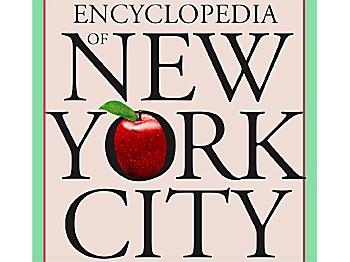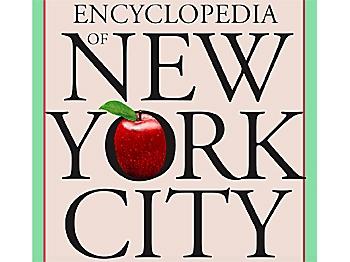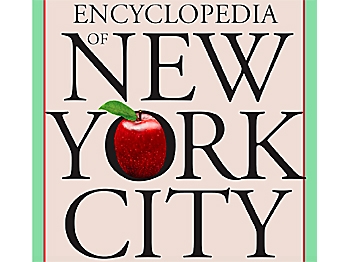Michael Bloomberg, bodegas, broken windows policy, Brooklyn cyclones, Chelsea Piers, Joe DiMaggio, graffiti, Harlem Renaissance, jaywalking, Bernard Madoff, MetroCard, Marilyn Monroe, parking—a few of the 2 million words in the nine-pound tome that squeezes all the complexities and intricacies of New York City between two covers.
“New York City has never been a static entity, and neither is ‘The Encyclopedia of New York City,’” writes Jackson in the preface.
The first edition was published in 1995. Jackson, the editor-in-chief, added 800 entries to his latest edition. With a total of more than 5,000 entries from about 800 contributors—experts on a vast array of topics—the book brings together the city’s multifaceted history in a way Google never could, says Jackson.
“Although third-graders may know how to use an Internet browser, browsing a book is a very different experience,” writes Jackson, “There is a joy in leafing through the pages to make unexpected discoveries about topics in which you did not think you had an interest.”
Just flipping through the “M” section to get to Marilyn Monroe, one is taken through the early days of a thriving marine economy up to the subsuming of Merrill Lynch by Bank of America in 2008. In between lie all sorts of interesting tidbits and the many stories that have formed this city’s history.
During World War II, the government secretly developed a nuclear weapon in a lab at 270 Broadway. The operation is known as the “Manhattan Project.”
“At one point the Columbia football team was recruited to move thousands of pounds of uranium for experiments that resulted in the first nuclear reactor,” writes Richard Rhodes, author of the encyclopedia entry and of “The Making of the Atomic Bomb.”
“Marine pollution” chronicles the history of the harbor. “It’s hard to believe that this was once an oyster city,” says Jackson. The first study of harbor pollution in 1907 deemed the mollusks unfit to eat. The water was described as “almost a thick black oil.” The city poured its sewage into the harbor from the time of the first Dutch settlers to Mayor Fiorello La Guardia’s reign in the 1930s. In 2009, the sludge boat, Red Hook, collected sewage to use as fertilizer, and volunteer groups began opening new oyster beds.
Continuing to flip through the pages, one comes across “Maybelline New York.” In 1915, chemist T.L. Williams observed his sister, Maybel, mixing Vaseline and coal dust to darken her lashes; a cosmetics empire was born.
Under mental health, one learns that convicts from the city prison once staffed the city’s poorly run asylums. The “Mercury Theater” entry tells the story of a broadcast that had many Americans believing Martians were invading. On Halloween, 1938, the theater produced a rendition of H.G. Wells’s “The War of the Worlds” that aired on the radio and was mistaken by some as a news broadcast.
“Merrill Lynch, Pierce, Fenner, and Smith” catches the eye as one flips nearer and nearer “Monroe, Marilyn.” The short article summarizes the history of the stockbrokers’ firm established in the early 1940s. It is a tale of success and innovation.
The firm was the first to publish annual reports, aggressively advertise, and prepare research reports, and training for new brokers—practices imitated throughout the industry in following years. The final two sentences summarize the most recent developments:
“In 2007 Merrill Lynch, Pierce, Fenner, and Smith was the largest brokerage firm in the United States, with more than 500 branches worldwide. It was acquired by Bank of America during the financial crisis in 2008.”
These few words speak volumes. This tome defies chronology, however, and one is drawn out of the economic woes of the present and into the life of Marilyn Monroe.
“It’s not about Marilyn Monroe’s life, it’s about Marilyn Monroe’s life in New York,” says Jackson. Monroe landmarks include the subway grate at 52nd Street and Lexington Avenue that set the scene for some iconic photos—and enraged her husband, Joe DiMaggio, as air wafted upward and brought her skirt with it; Madison Square Garden, where she sang “Happy Birthday” to John F. Kennedy in 1962; and the list of addresses she called home, some psychiatric centers among them, unfortunately.
Professor Jackson spoke about his encyclopedia at The Tenement Museum Shop on the Lower East Side shortly after its release. Lining the walls of the shop were hundreds of books: “Graffiti New York,” “Brooklyn Then and Now,” “Five Hundred Buildings of New York,” and many more.
The length of entries in “The Encyclopedia of New York City” averages 200 to 800 words, far from comprehensive explorations of each topic. It does, however, touch on many topics of interest in this city of endlessly interesting phenomena. The topics are ordered alphabetically, rather than by theme or chronology, bringing to the reader a random assortment of knowledge—a characteristic unique to this form.
“It’s a city of mystery, the unexpected, and of diversity,” said Jackson.
Changing Face of New York: 1995 to 2010
There have been some smaller changes—the Nabisco factory became the Chelsea Market; the minor league farm team for the Mets, which was named the Cyclones after the Coney Island roller coaster, formed in Brooklyn—and some more dramatic changes.
Jackson pointed out that “9/11 is probably as big a difference as you can find.” He had the highest praise for the Fire Department of New York (FDNY). He dedicated five pages to firefighting in a book that barely has any entries over two pages, and usually only half a page or less.
“They didn’t say, ‘you’re not paying me enough to do this,’” said Jackson; instead, they got to work right away, even if they were not on duty. A little-known fact is that every single member of the FDNY elite team, the team that is called when the firefighters themselves need rescuing, Rescue One, was killed on Sept. 11, 2001. Their command post was under the World Trade Center.
New York is constantly growing and changing. Development is everywhere, from Citi Field, the new home of the Mets, to Trump Tower, completed in 2001.
“You can like them or not like them, but they are the signs of change,” said Jackson of the skyscrapers built by real estate tycoon Donald Trump. Jackson argues that New Yorkers no longer want space—they want what’s happening instead: places to eat, to see a show, and to have a night out.
Some audience members at the Tenement Museum Shop insisted that historic buildings are too often lost to new developments. Jackson said he lives in a historic area and appreciates that aspect of the city, but also stated:
“The city I came to, I want to continue to see grow and change. … If you’re about history, you’re not about now.” Jackson says the city is about the hustle and bustle, about movement and change.
The drop in crime rate over the last 15 years is the biggest change as Jackson sees it. The encyclopedia includes a list of television shows set in New York City. He noted that the city used to be associated with shows such as Escape From New York, Death Wish, and Midnight Cowboy. Now it is better known for Seinfeld and Friends.
New Yorkers watch their city change
Perry (last name withheld upon request) has lived in Manhattan for more than 30 years. He says the biggest change in the last 15 years has been:
“Wealth—it’s overtaken New York. Gentrification—and that’s a bad thing.”
Jocelyn Strutt, a 34-year-old fashion designer, has lived in many different parts of the city since she graduated from college 12 years ago.
“The different neighborhoods have transformed a lot,” said Strutt. She sees a safer city with more places to enjoy. In the Lower East Side, “you couldn’t go past Avenue A [before], and now you can go all the way down to Avenue D and it’s totally safe and hip and fun,” says Strutt.
She moved from the Lower East Side to Hell’s Kitchen, which she also saw open up. She says past Eighth Avenue was a bad part of town and she would not venture there before. “Now you can go down to Ninth and 10th and it’s all built up.”
She moved to Tribeca Sept. 1, 2001, and watched the area’s metamorphosis from 9/11 up to now. Businesses were hit hard, and a lot shut down after the terrorist attack, she recalled. Strutt credits Lower Manhattan Commission grants for helping to revive the area.
“I watched that whole downtown area come back to life, which was pretty amazing,” recalled Strutt.











